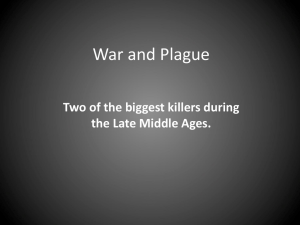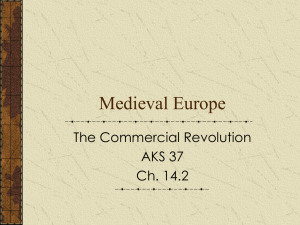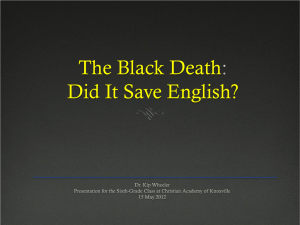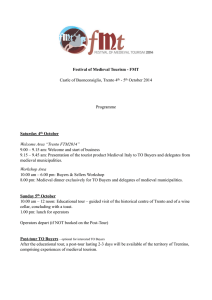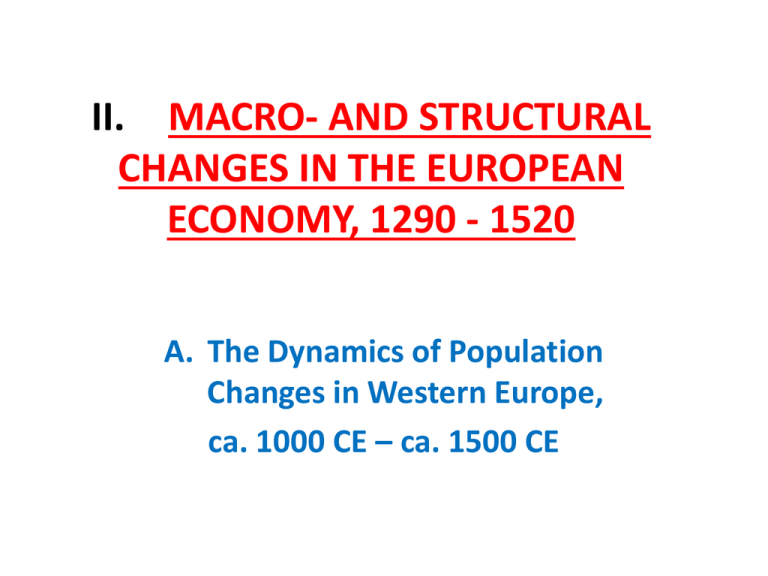
II. MACRO- AND STRUCTURAL
CHANGES IN THE EUROPEAN
ECONOMY, 1290 - 1520
A. The Dynamics of Population
Changes in Western Europe,
ca. 1000 CE – ca. 1500 CE
Dynamics of Medieval
Population, to 1500:
Part B
1. Ricardo and Malthus on Population
2. Mortality (Diseases), Fertility, and
the European Marriage Pattern
The Classical Economists:
Population and the Economy
• 1) Two 19th-century Classical Economists have
influenced to this day our interpretation of how
demographic changes influenced the economy:
• (i) Thomas Robert Malthus (1766-1834)
• (ii) David Ricardo (1722 – 1823)
• 2) Note that the Law of Diminishing Returns is
crucial to both their models: but that concept
was unknown till the late 19th century
• 3) Malthus’s Subsistence Crisis model was done
last day – now we turn to Ricardo
Evolution of the Ricardo Model 1
• 1) Ricardo’s own, original theoretical model:
on differences in productivity between two
pieces of land, using same capital and
technology
• 2) Johann von Thünen (1783-1850): German
economist who added the importance of
differences in distance to markets and thus of
transportation costs
Evolution of the Ricardo Model 2
• 3) ‘Marginalist’ School of Economics,
culminating with Alfred Marshall (18421924): importance of the margin:
• - marginal utility, marginal productivity,
marginal cost, marginal revenue leading to
• 4) Law of Diminishing Returns (last day):
especially to explain the Malthusian model of
subsistence crises
David Ricardo on Economic Rent
• Economic rent on land is the value of the
difference in productivity between
• a given piece of land and the poorest piece of
land (or the land most distant from the market)
• producing the same goods (bushels of wheat)
under the same conditions (of labour, capital,
technology, climate)
• Essence of argument: wide differences in
production and marketing costs between the best
and worst lands called into production to feed a
given population
Productivity in Ricardian rent
• Productivity of agricultural land defined by:
- (1) the natural fertility of the soil: as utilized
by given technology and stock of capital
- (2) the distance from the market in which the
grains (or other agricultural goods) are sold
- (3) so: the productivity differences involve the
costs of both producing and marketing the
grains in a given market.
Population Growth & Ricardian Rent
• Population growth forces into production
new lands that are (almost by definition)
higher cost marginal lands (marginal = extra)
• Such marginal lands are higher cost for
reasons already seen:
– (1) inferior soil fertility
– (2) and/or greater distance from the market, and
thus requiring higher transportation and
marketing costs (Von Thnen’s contribution)
Population growth & rising rents
• The price of grain is determined by the marginal cost
of producing the last (marginal) bushel of grain on the
last (marginal) unit of land brought into production,
from distant markets
• Only one price for grain can prevail in any market:
determined by the marginal cost of producing grain
and supplying it to the market (cf von Thünen model)
• Economic rent is thus the surplus value created by the
difference between the production costs on each unit
of land: from the best (highest, closest) to the worst
unit and/or most distant land
• which has no economic rent)
Long-Term Elasticities of Supply
• (1) Supply elasticities (more than demand
elasticities) help to explain:
• - (a) trends in long-term prices
• - (b) differences in economic rents accruing on
lands for crops, pasture, industrial production
• (2) Changes in supply curves with population
growth: see the Ricardo graph
• (a) grains (arable): steeply sloping supply curves
• (b) livestock products: less steeply sloping
• (c) industrial products: flat, or gently sloping
Related definition of economic rent:
OPPORTUNITY COST
• The excess or surplus of total payments given to
any one factor of production (land, labour,
capital) over and above its ‘transfer earnings’
• Transfer earnings: the payment required to keep
that factor of production in one use and to
prevent its transfer to another use
• Opportunity cost: the cost of doing A is the
benefit forgone, earnings not received, by doing
B: i.e., transferring that factor from A use to B use
Opportunity cost & Economic Rent
• Thus economic rent is the extra amount of payment that a
factor production receives over and above its transfer
earnings:
• For Ricardo’s agrarian model: that land had only one use -- growing grains → so: no ‘transfer earnings’ were possible
• Thus: all rent is surplus to what was necessary to keep that
land in its present use growing grain
• The difference between the market price for grain and the
costs of producing it was therefore pure economic rent,
which was expropriated by the landlord
• The tenant would stay on the land so long as his own
‘transfer earnings’ were met: so long as he earned enough
not to seek alternative employment.
Consequences of Population Growth
in the Ricardian model
• (1) GRAIN PRICES WILL RISE
• (2) LAND RENTS WILL ALSO RISE - BECAUSE
OF THE INCREASES IN ECONOMIC RENT
• (3) REAL WAGES WILL FALL:
• - because of the rise in the cost of living
• - because of changes in the land: labour ratio,
leading to a fall in the marginal productivity of
labour
Real Wages in the Ricardian Model
• Real wages are determined by the marginal
revenue product of labour,
• which depends on changes in values of
products produced and sold on the market
• -in theory, population growth reduces the MP
of labour (see: DIMINISHING RETURNS)
• RW = MRP (L) – or:
• RW = NWI/CPI
Consequences of Population Decline
in the Ricardian Model: I
• (1) GRAIN PRICES WILL FALL –
• as higher-cost marginal lands fall out of
production and grain is produced on better
quality, lower cost lands, with less labour
• and on lands closer to the market
• (2) LAND RENTS WILL ALSO FALL:
• as declining prices reduce the difference
between the market price and production
costs
Consequences of Population
Decline in the Ricardian Model: II
• (3) REAL WAGES WILL RISE:
• - as the cost of living falls: with lower priced
grains supplied to the market
• as the marginal productivity of labour rises
• i.e., since fewer persons (units of labour) are
needed to produce a given quantity of grain
for the market:
• See LAW OF DIMINISHING RETURNS
Who captured the economic
rents?
• According to both David Ricardo and Karl Marx,
the landlord, as the unchallenged owner of the
lands, captured all the economic rent
• He could supposedly evict all tenants who
refused to pay and replace them with others
• In historical fact, however, that never happened:
an examination of medieval feudalism and
manorial farming: demonstrates that those rents
were shared between landlords and tenants
Who captured the economic
rents?
• FEUDALISM, MANORIALISM, SERFDOM: are topics in
which these issues will be more fully explored (under
Agriculture).
• Surprising anomaly:
• manorial courts fixed ‘customary rents’ in nominal
money terms (next topic) in perpetuity (inheritance)
• so that population growth and thus rising grain prices
meant that such ‘customary’ tenants captured all the
economic rents – at expense of landlords
• The landlord reaction: to alter manorial structures
(landlord-tenants relationships) in order to convert
customary peasant tenures into short-term leaseholds
POPULATION CHECKS: I
• MALTHUS TYPE I: PROVIDENTIAL OR
POSITIVE CHECKS
• Four Horsemen of the Apocalypse: war,
famine, plague (pestilence) and ??
• endogenous: results of Malthusian
overpopulation?
• or exogenous shocks to the economy?
• Malthus: not the most important type of
demographic checks in European history
POPULATION CHECKS: II
• MALTHUS TYPE II: PRUDENTIAL OR PREVENTIVE
• Demographic self controls on fertility: by
marrying later, with sexual abstinence
• ‘moral restraints’ on sexual behaviour
• What about contraception – birth control?
• NO: Malthus was a Protestant clergymen when
Protestants were as opposed to artificial birth
controls as were Roman Catholics;
• Infanticide: was also, needless to say, not
acceptable!
DEATH RATES: MORTALITY
• DEATH RATES: usually more important than birth
rates: since birth rates were normally 25 to 35
per thousand,
• while medieval death rates could soar from 25 to
400/1000 (Black Death)
• birth rates became more important at outset of
the modern Industrial Revolution :
• accounting for 70% of population growth from
the 1760s to the 1830s
• Why?: the later European Marriage Pattern
• Today in Canada: BR is 11/1000; DR is 7/1000
Medieval Diseases & Death Rates
• Chief medieval diseases:
• plague (bubonic, pneumonic, septicaemic),
• pneumonia, dysentery, typhus, leprosy, and
tuberculois (and influenza??)
• Early-modern and modern diseases:
• syphilis, small pox, and
• then cholera (late 18th, 19th centuries)
Transmission of diseases
• Medieval & early-modern view:
• Miasma theory: diseases came from noxious
vapours in atmosphere: from 12th century
• not until scientific experiments of Koch
(German) and Pasteur (French) in 1870s did
we know the bacterial causes of diseases
• Modern Reality (from 1870s):
• water supplies and sewage: chief vectors for
transmission of bacterial diseases
The Black Death: Plagues I
• (1) The Justinian Plague: ca. 540 – ca. 750
• the First Pandemic: named after Byzantine
Emperor Justinian (527-565 CE): from 6th to 8th
centuries: in Asia, Africa, and Europe
• (2) The medieval Black Death: from late 1347
to about 1733: (revisit this next term)
• the Second Pandemic: disappearing from
western Europe 1730s, it remained in the
Russian and Ottoman Empires to the 1820s
The Black Death: Plagues II
• (3) The Third Pandemic: 1894 - 1947
• modern bubonic plague: afflicted Asia –
especially China and India
• - still remains endemic in Asia, SW United
States
• provided modern medical knowledge of
bubonic plague (Yersinia pestis)
• - but very different from the medieval and
Justinian plagues. WHY?
Types of Plagues: I
• (1) Bubonic Plague: 60% to 80% mortalities
• May have killed 40% of European population in the mid
14th century
• Causes?
• Supposedly the plague bacillus (bacteria) known as
Yersinia pestis, absorbed by blood-sucking fleas
(Xenopylla cheopis, Nosopsyllus fasciatus),
• fleas that were parasitic on black rats
• did not attack humans so long as there were ample rats
• Pulex Irritans: the role of human fleas??? Disputed
Types Plague: II
•
•
•
•
(2) Pneumonic Plague:
with mortalities up to 99%
killed rich and poor alike, healthy and infirm
Spread by sputum and human breath: from
the lungs
• Evidently a mutation of bubonic plague
• How common is matter of great dispute
Types of Plague: III
•
•
•
•
•
(3) Septicaemic Plague:
- mortalities up to 90%
- infection from bacteria in the blood stream:
- from open sores and wounds
- apparently, very rare: past and present
Problems with Rat-Flea Theory: I
• In the Third Pandemic (1894-1947), all Indian
villagers knew when bubonic plague was
coming: from the presence of thousands of
dead rats on village roads and fields
• Note: rat fleas will not attack humans unless there are not enough rats left alive
• But no medieval chronicler, nor medieval
records, indicate the presence of any rats, let
alone dead rats, in plague infested areas
Problems with Rat-Flea Theory II
• Third Pandemic: 1894 – 1947
• plague travelled very, very slowly, with low
mortalities (under 10%)
• Followed grain supply routes: which fed rats
• But medieval Black Death spread like wild-fire
across almost all of Europe, within two years;
and with no relation to the grain trades
• With high mortalities – killing 40%-50%
Problems with Rat Flea Theory III
Transmission Problems with rats and fleas
• Rats do not travel far,
• and travel slowly
• fleas also do not travel, do not leave their
hosts (rats or humans)
• most fleas infected with plague bacteria will
die with a matter of days: esophagus severed
• fleas do not hibernate with plague bacteria
Current Plague Historians
(1) Samuel Cohn:
• has convincingly raised all these problems:
• does not believe that the Black Death was
pneumonic plague,
• nor that the plague flea was Pulex irritans
(2) John Kelly, John Theilman, Frances Cate:
- Black Death was bubonic plague, caused by
Yersinia pestis, but a far more virulent form:
- but they do not explain how it spread!!
(3) Ole Benedictow: ignores Cohn & others
Warfare
• Warfare: endemic, a spreading stain, from the
1290s to the 1450s, in western Europe:
• 1290s a major turning point: warfare across most
of Europe and Mediterranean led into better
known Hundred Years War (1337-1453)
• Wars: not major killers in terms of battle deaths,
• but were in terms of wounds & diseases, and in
causing famines
• Warfare: disrupted food production and trade
• polluted water supplies: rotting bodies
Famines
• Famines: often a serious threat, but not often
major killers
• Famines resulted from adverse climate
changes : bad weather → too wet, too dry
• Or from disruptions to both agricultural
production and trade: especially from warfare
• Great Famine of 1315 – 1322: fortuitous
result of temporary climatic changes?
• Chronic malnutrition: more serious factor,
reducing resistance to diseases
Mortality and Birth Rates
• Famine, malnutrition, diseases (especially
plague) often seriously reduced fertility:
• - amenorrhea (disruption of menstrual cycle)
• High infant mortalities from malnutrition and
diseases (esp. plague)
• effectively reduced the ‘live birth’ rate and thus
the replacement rate to produce new generations
of surviving children
• Maternal mortalities: dying in child birth: not as
much as often imagined, but a problem
The European Marriage Pattern
• John Hajnal: “The marriage pattern of most of
Europe [except eastern Europe], as it existed
for about two centuries up to 1940 was…
unique. There is no known example of a non
European civilization which has had a similar
pattern.”
• Prudential or Preventive checks to population
growth: for Malthus, key to demographic
problem – anticipating concept of the EME
Europe in 1914
The European Marriage Pattern in the 19th century: Europe west of the
line from Saint Petersburg (Russia) to Trieste (Italy)
Components of the EMP
• known as Low Pressure Demographic System
• (1) Nuptiality: a high age of first marriage for
women: in late 20s or early 30s
• (2) Celibacy: a significant proportion of
women who never married: from 15% to 30%
• (3) Nuclear families: father, mother, children –
and relatively few children
• (4) Wealth and Incomes: help determine age
of first marriage and family size
Servants in Husbandry & the EMP
• post-Black Death phenomenon: may be related
to origins of the EMP
• With growing scarcity of labour, many rural
households began hiring young people – chiefly
teenage women – to assist in agricultural tasks
• Lived as members of the (nuclear) family while
doing farming tasks
• Received board, room, clothing, annual salary
Servants in Husbandry & EMP II
• Condition of Service: that they not marry (or
procreate) while living in the household as
servants
• Thus: such women might work as agricultural
servants to their late 20s: then retire with
substantial cash dowries
• major factor in delaying the age of marriage
• - to the late 20s
The Universal Marriage Pattern
• known as: High Pressure Demographic System
• Prevailed in all the ancient world, in all of Europe
before the early modern era, in eastern Europe
until the 20th century, and in all of the rest of the
world (Asia, Africa, Americas)
• UMP: for both nuptiality and celibacy
• Almost ALL women married
• Almost ALL women married by late teens
The UMP in Medieval Tuscany:
1427
Mean marriage ages in Tuscany
(1427): rural
Mean marriage ages in Tuscany
(1427): urban (Florence, Pisa, etc.)
Modern Day Asia
• - Universal Marriage Pattern: is disappearing,
but with widely varying patterns
• - depends in part on marriage customs:
continuation of parentally arranged marriages vs.
freely chosen marriages
• JAPAN: with far greater economic and personal
independence, and higher education, Japanese
women are marrying later – if at all – around 30
• - about a third of women remain unmarried
High and Low Pressure Regimes
• (1) High pressure demographic regimes
• Universal Marriage Pattern
• -fertility at its biological maximum: in the late
teens, early twenties
• -therefore mortality is the governing factor
• (2) Low pressure demographic regimes
• - EMP: mortality and fertility fairly low
• But fertility the more dynamic factor, with
changes in both nuptiality and celibacy
EMP and Fertility
• earlier marriages, with more time for
procreation, led to larger families, especially in
eras of low life expectancies
• Fertility: is much, much higher in late teens,
low 20s; and falls very sharply in the 30s
• -these findings are also borne out by recent
Canadian studies:
• From ages 20-24 to 35-39, the live birth rate
falls by 39.4% : from 409/1000 to 248/1000
Other Fertility Control Factors
• (1) sterility and amenorrhea: as discussed
• (2) contraception: evidently widely practised,
especially coitus interruptus (onanism)
• (3) sodomy (aka: buggery: anal intercourse)
• (4) condoms: from the 16th century
(sheepskin)
• Illegitimacy? - accounted for 10% of all first
births, but only 1% - 4% of total births: most
pre-marital pregnancies led to marriage
EMP and Mortality
• EMP: lower birth rates better preserved the
health of both women and children
• i.e., smaller families better ensured higher living
standards – or reduced malnutrition
• The concept of the EMP is implicit in Malthus:
• as the primary form of the Prudential checks
that prevented ‘Malthusian Crises’ of
overpopulation (and thus higher mortalities)
• But when and where did the EMP begin??

